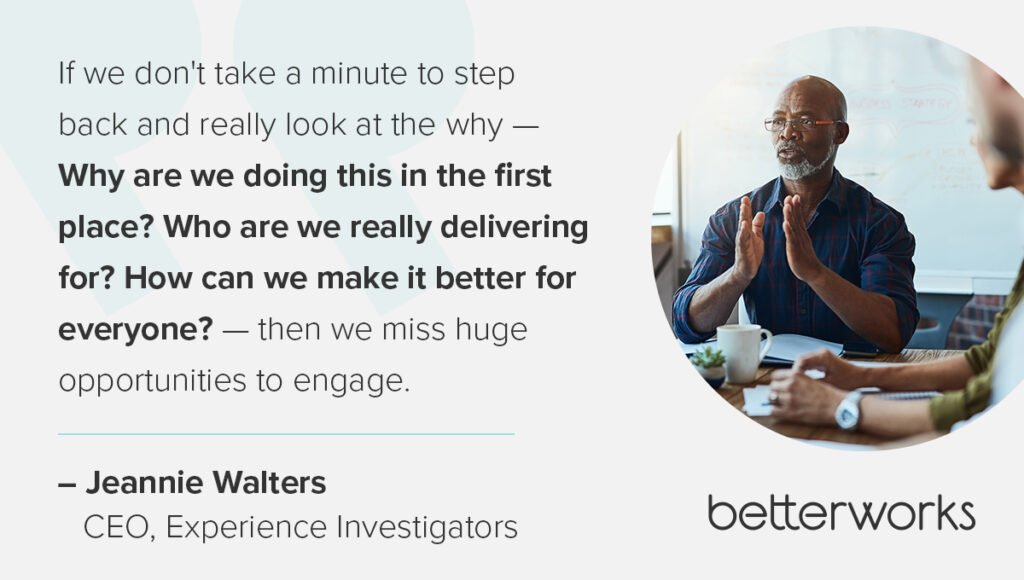Employee and customer experiences are deeply intertwined. To bring out the best of both, we need to design customer-centric employee experiences. Delivering better customer experiences is a priority for most businesses, but rarely do business leaders empower employees to be more involved in achieving that goal.
“We talk a lot about these subjects, but we don’t necessarily give people the tools to understand, ‘How do we create the right vision?’” said Jeannie Walters in her People Fundamentals webinar for Betterworks. As a customer experience expert and CEO at Experience Investigators, Jeannie has made it her mission in life to create fewer ruined days for customers. Empowering employees to be more engaged in delivering great customer experiences lies at the heart of her mission.
Check out highlights from Jeannie’s session to learn how to strategically align employee and customer experiences and elevate overall business performance. You can also listen to our People Fundamentals podcast to catch her presentation.
Subscribe wherever you listen to podcasts: Apple Podcasts | Spotify | YouTube Music
Experience your brand through someone else’s perspective
Understanding the purpose behind developing better experiences helps you take a more targeted approach to designing and deploying them. “If we don’t take a minute to step back and really look at the why — Why are we doing this in the first place? Who are we really delivering for? How can we make it better for everyone? — then we miss huge opportunities to engage,” Jeannie said.
By proactively managing customer experiences, and empowering employees to participate in that process, you can better adapt to changing expectations and address individual needs, ultimately improving loyalty and retention for both customers and employees.
One way to start is through journey mapping, which helps you understand pain points in both the customer and employee experiences and highlights where you can make small changes that could drive a big impact. “By going through employee journey mapping, you can actually start seeing things — like those moments of neglect — that you can just make a little better, that you can maybe provide something that creates a little less friction for that employee,” Jeannie said.
As you engage in journey mapping, be sure to take a step back and really consider the experience from someone else’s viewpoint. “If you can actually walk in the shoes of your customer, of your employee, what is it actually like from their perspective?” Jeannie said. “Because sometimes we are really focused on process mapping, on understanding process — but we don’t ever look at the other side of that equation and think about what’s actually happening for the person experiencing that.”

Involve employees in the customer experience journey
Although we tend to think of customer experience being concentrated in customer service teams, even employees not working on the frontlines influence both initial awareness and the overall experience that follows. But many employees don’t realize what an important role they play in delivering great customer experiences.
“They don’t think it applies to them because we don’t really talk about it, we don’t connect the dots,” Jeannie said. Since every task and process within an organization ultimately aims to better serve customers, employees handling tasks like distribution, invoicing, or HR still shape customer satisfaction based on their work.
By understanding how their daily work impacts customers, you can empower all employees to prioritize and actively participate in delivering better customer experiences. Rather than viewing customer-centric work as an additional duty, help team members understand how it’s core to their existing responsibilities.
When you can align employee job functions with customer outcomes, you enable employees across roles and functions to participate in an intentional customer experience strategy.

Prioritize proactive customer service
Organizations must shift from reactive firefighting to intentional experience design. “Proactive positive customer experience actually prevents service issues,” Jeannie said. By understanding root causes, you can empower employees to eliminate problems before customers notice.
Experience-driven cultures unlock top performance and profits for all stakeholders. But without leadership buy-in, you can’t take customer or employee experiences to the next level. Jeannie urges companies to treat experience initiatives like core business functions, not add-ons. “We cannot say something as a priority and give it no funding or resources. When things are a priority, we have to actually treat them like they’re part of the business,” she said.
Through journey mapping, goal-setting, and ongoing engagement, employees feel empowered rather than overloaded. And at the same time, customers receive seamless, enhanced support surpassing expectations at every turn.
Without quantifying impact, however, the benefits of better experiences remain abstract rather than actionable. “I typically see KPIs in customer experience as feedback metrics a lot of the time,” Jeannie said. “So you might have goals around Net Promoter Score, for instance, or customer satisfaction rate.” Linking better experiences to tangible data within your organization can help you take concrete steps toward higher employee engagement and better customer service — driving better business results.
Want to learn more? Watch Jeannie’s presentation on demand.
Align EX and CX








